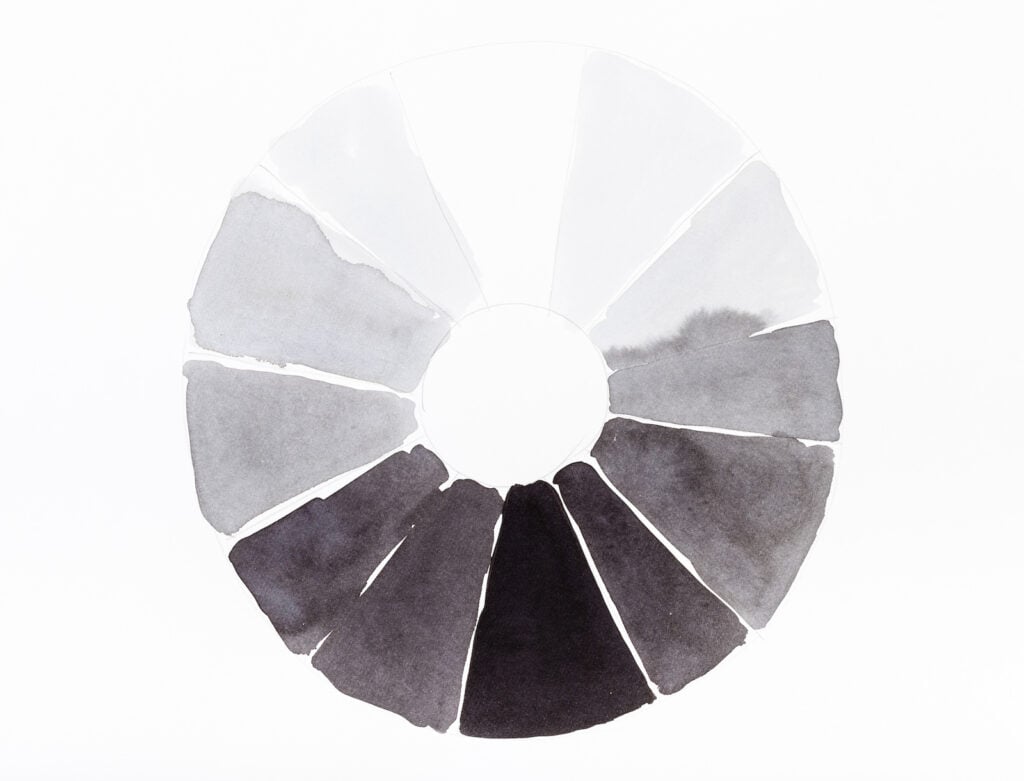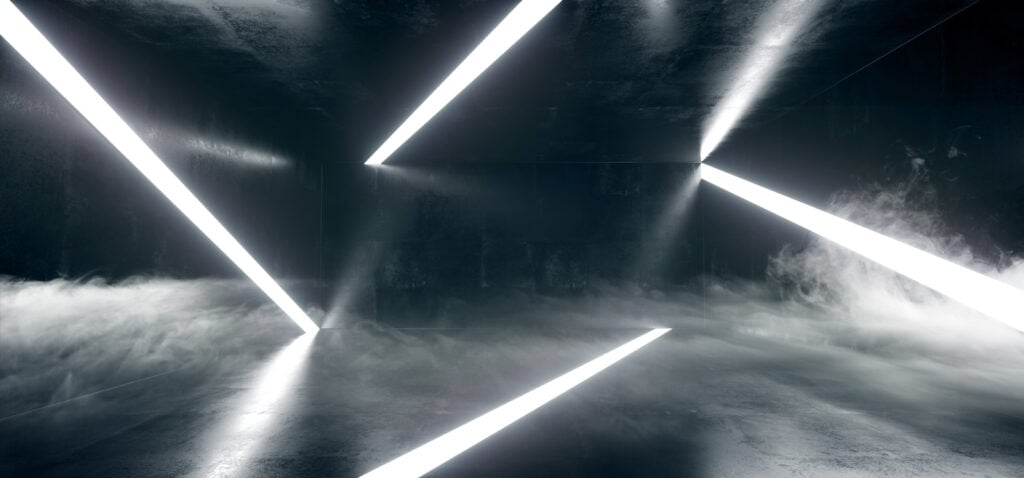
Black and white are two very different colors. One is light and calm, while the other is dark and intense. They’re often used to contrast each other, such as in the yin yang symbol and on chess boards.
By definition, black and white are not colors because they don’t have their own wavelengths. Yet, many people still refer to them as such because they’re hues that we can see with our eyes. So, is it possible to mix black and white together, and what happens if you do?
What Color Do Black and White Make in Paint?
Mixing black and white is interesting because their purpose in paints is the opposite of each other. White is mixed with colors to lighten them, while black is used to darken them. A mix between black and white would be a darker white or a lighter black, depending on how you look at it.
So a combination of black and white creates gray. Adjusting how much white and black is used in the mixture can help you make gray lighter or darker.
Why Are Black and White Not on the Color Wheel?

When working with paints, we usually look at the RYB color model to see what different colors make when mixed. For example, red, yellow, and blue are the primary colors. The color model shows us that combinations of the primaries can make green, purple, and orange. However, black and white don’t appear on the color wheel.
Black and white aren’t seen on the RYB color model because they’re not a part of the spectrum. Yet, they can still be used in paints, but mixing with them doesn’t create a new color. Instead, mixing with black or white only makes a lighter or darker version of the other color.
Making Gray Lighter or Darker
Adjusting the color gray is a straightforward task. You can make the color lighter or darker simply by using black and white.
Tints of Gray
Tints are colors that have white added to them, which makes them lighter. Adding white to gray will make it a lighter version of the color. When mixing black and white, you can also start off with much more white than black to create a lighter gray.
Shades of Gray
Shades are the opposite of tints. They’re created by adding black to a color, which makes it darker. However, black can easily overpower other colors, especially white, so a little black paint can go a long way. Add a hint of black to gray to create a shade of it. Starting the mixture with more black than white is another way to make your gray darker.
Gray Color Meaning

Gray is a neutral color that can have a wide range of meanings. It often symbolizes compromise, control, and practicality. It can stabilize, calm, and relax those who look at it.
Like all colors, gray has both positive and negative meanings. Some positive meanings include reliability, maturity, and intellect. However, it could also represent pessimism, sadness, or indecisiveness. The meaning can vary based on the context in which the color is used.
Can You Make Black and White Paint?
If you run out of black or white paint, you might be out of luck. Since these two colors don’t appear on the color wheel, they’re some of the most difficult hues to create. In fact, there’s no way to make white paint using other colors. White is the absence of color and wavelengths, so mixing any colors together will have at least one wavelength in the mix, making it not pure white. There are some ways to create white paint with other household materials, but it’s easiest to buy new paint instead.
However, there are some ways to create black paint. The most common way is to mix the primary colors together. Unfortunately, red, yellow, and blue usually make brown instead of black. Yet, if you use deeper versions of the primary colors, such as ultramarine blue, crimson red, and yellow ochre, they’re more likely to make black. Another option is to mix blue with brown paint. It’s fun to experiment with different ways to create black paint, but it’s easier to just buy more.
What Color Do Black and White Make in Lights?

You can’t mix black and white lights because black-colored lights don’t exist. Black isn’t on the visible light spectrum or on the RGB color model, which is used for lights and digital displays. The RGB color model’s primary colors are red, green, and blue. Combinations of the colors make magenta, cyan, and yellow. When all three primary colors are mixed at full brightness, they make white.
Even though there’s a type of light called a “black light,” it’s not the same as a black-colored light. Black lights appear violet to us because they produce ultraviolet rays. So, while we can see the color black, you’ll never see a light that looks black.
Why Can Lights Not Be Black?
When all the lights are turned off, everything around us looks black. That’s because black is considered the absence of color and light. Normally, colors can be made on the RGB spectrum by combining the three primary colors at different brightnesses. However, the only way to create black is to completely tone down the brightness on all colored lights, which is the equivalent of turning the lights off.
You might be wondering how we can see the color black if it doesn’t exist in lights. If you think about it, there are other colors we can see that don’t appear on the visible light spectrum, such as brown and pink. That’s because when we look at colors, we rely on our eyes and our brains at the same time. Our eyes see colors based on wavelengths, but our brains provide context to help us see a wider variety of colors. Thus, we can’t see every color in lights, but our brains help us see colors like black and brown.
How Do Our Eyes Perceive Color?

A lot goes on in our eyes when looking at colored lights. Our eyes perceive colors based on the wavelengths that reflect off objects. Each color on the visible light spectrum has different wavelengths. For example, violet has short, frequent wavelengths, while red is the opposite with long, stretched-out wavelengths.
When light shines on an item, some wavelengths are absorbed into the object and others bounce off it. So, if you look at a red apple, all the shorter wavelengths will be absorbed while the longer ones that represent red will reflect toward you. These wavelengths are measured in nanometers, which are one-billionth of a meter.
Inside our eyes, we have cone and rod cells. Those cells help us perceive the colors during different times of the day. When the space around you is bright, the cone cells help you perceive colors. The rod cells perceive colors better in dim light since they’re more sensitive. Together, these cells help your eyes see colors, and then your brain helps you understand the context of unique colors.
Read more about how your eyes and brain work together so you can see color.
Do Black and White Exist in CMYK?
CMYK is the color model used for ink. The primary colors are cyan, magenta, and yellow, while the secondary colors are red, green, and blue. Even though it seems similar to the RGB color model, black exists in CMYK, but white does not. So it’s the opposite of RGB.
When all three primary colors mix together in CMYK, they make black. The “K” in CMYK stands for “key color,” and the key color is black. However, white is the color of printer paper. So, no ink needs to be added to create white when printing. White only occurs on the paper when no ink is being used because none of the colors on the CMYK color model can be mixed to make white. Also, white isn’t one of the ink cartridges you’d add to your printer.
So, if you tried to mix black and white in CMYK, you’d just get black because you’d be putting black ink onto white paper. There’s no easy way to mix the two colors like there is in painting.
Black and White Designs

Black and white together make bold designs because they contrast each other. That’s why you’ll see them together in striped or checkered patterns. Using only white and black can be a bit overwhelming to look at, so you might want to consider adding an additional color to the mix.
If you’re looking for some interesting colors to use with black and white, you should consider adding green, blue, pink, yellow, red, or lavender. However, both black and white are neutral colors that go well with nearly any color, so there are endless color combinations to try. A black and white room design usually gives off a professional feel.
However, if you don’t want to use black and white together, you can use them separately with just about any color. Black can be an overpowering color in all types of designs though, so be sure to only use it sparingly.
Mixing White and Black Can Be Tricky
Mixing black and white can be a complicated process. In painting, black and white make gray, but it’s difficult to create the two colors from scratch. In RGB, black doesn’t exist, and in CMYK, white doesn’t exist. So, it’s impossible to mix that pair in those color models.
However, color mixing isn’t always this confusing. Most combinations make a unique color in each color model, and some even create the same color in every color model. So, to learn more about color theory, try mixing a variety of colors to see what results you get.







